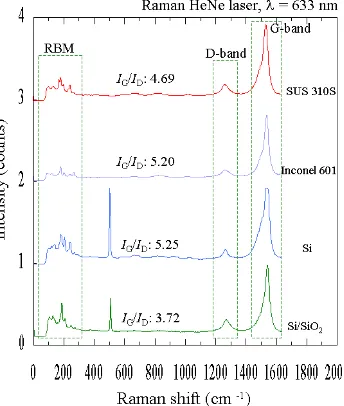1.
Fig. 1. Raman spectra of SWCNTs on different substrates.
Controlling the growth of vertically aligned single walled carbon nanotubes from ethanol
for electrochemical supercapacitor application
Mohd Asyadi Azam*, Mohd Ambri Mohamed, Eiji Shikoh, Akihiko Fujiwara, and Tatsuya Shimoda
School of Materials Science, Japan Advanced Institute of Science and Technology, 1-1 Asahidai, Nomi, Ishikawa, 923-1292 Japan
Tel: +81-761-51-1553
Carbon materials such as carbon nanotube (CNT) are theoretically known to have abilities and remarkable properties when used as electrodes in electrochemical capacitors (EC) [1]. The single walled CNTs (SWCNTs) were experimentally proved to have very large specific area to suit the requirement of EC devices [2]. Various methods including the chemical vapor deposition (CVD) have been developed to grow vertically aligned CNTs (VA-CNTs). Among them the alcohol catalytic CVD (ACCVD) method [3] is a promising one which is well-known for its economical merit, wide selectivity of substrates and yielding catalytic reaction to grow the CNTs. For the application of EC devices (supercapacitor etc.), it is desired to directly grow the CNTs onto conducting substrates to fabricate electrodes. This procedure not only can eliminate CNT transfer process but also can avoid the contamination and the increase in device resistivity by binder material. In order to achieve desired CNTs for the application above, the CNTs production must be controlled to have the predetermined properties, which would be possible if their growth mechanisms were well understood [4].
Here, we report on the growth of VA-SWCNTs using the ACCVD technique. Al2O3-supported Co catalyst and high purity ethanol
(carbon feedstock) were used for the growth process. Both Al layer and Co thin-films were deposited using an electron beam evaporator. The Al layer of 20 nm nominal thickness was manually oxidized before the deposition of 0.5 nm Co. The CNT growth was optimized using Si/SiO2 substrates, and the selected growth parameter was applied to
each conducting substrate such as Inconel 600, Inconel 601, Si, and SUS 310S. In order to understand the mechanism of the CNT growth, synthesis of the catalyst nanoparticles and their structural characterization before CVD growth were carried out using atomic force microscope (AFM), scanning electron microscope (SEM), and x-ray diffraction (XRD). The properties of the as-grown CNTs were mainly characterized using Raman spectroscopy and SEM. Figure 1 depicts the variation of Raman spectra of CNTs on the different substrates measured by 632.8 nm laser excitation. Raman spectrum of almost all the samples involved peaks of radial breathing mode (RBM) from 100 to 250 cm-1, which revealed the presence of single-walled CNTs, D-band (defect, amorphous carbon) around 1310 cm-1, and G-band (graphite) around 1590 cm-1. This preliminary result confirmed that the CNTs could also be effectively grown on the conducting metal substrates by using our ACCVD system.
ACKNOWLEDGEMENTS
The financial contribution for this conference was made by the Ministry of Higher Education (MOHE) and Universiti Teknikal Malaysia Melaka (UTeM), Malaysia. This work was also supported by a Grant-in-Aid for Scientific Research on the Priority Area from the Ministry of Education, Culture, Sports, Science and Technology (MEXT), Japan. Part of this work was conducted in Kyoto-Advanced Nanotechnology Network, also supported by MEXT.
REFERENCES
[1] E. Frackowiak et.al., Carbon 39 (2001) 937.
[2] T. Hiraoka et. al., Advanced Functional Materials 20 (2010) 422.
